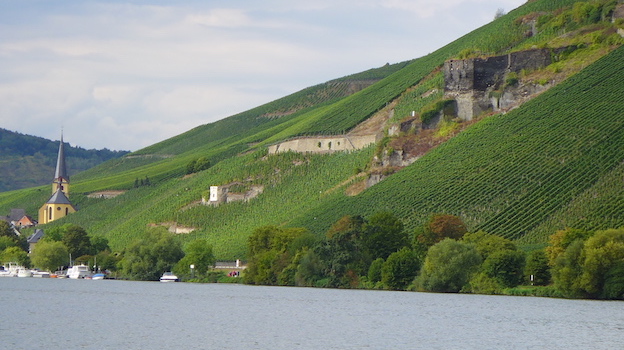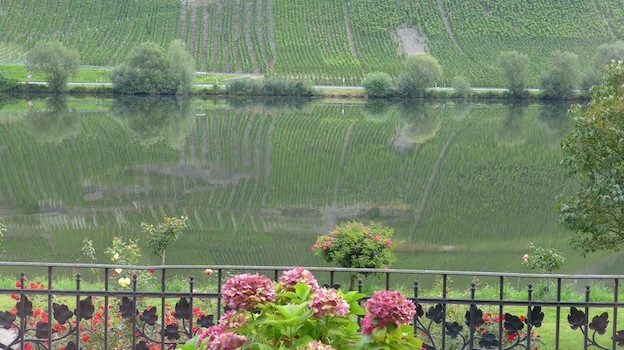Browse using the new Vinous website now. Launch →
Printed by, and for the sole use of . All rights reserved © 2015 Vinous Media
2014 on the Mosel: Man Bats Last
BY DAVID SCHILDKNECHT | NOVEMBER 17, 2016
Part 2: From Wehlen to Winningen
This concluding installment to my account of Germany’s 2014 Riesling vintage covers many of the villages where rain in early autumn presented the greatest challenge, and not just because these locations endured more of it, but because rain hit at a point where the fruit was only on the cusp of ripeness. Thus many growers had to choose between harvesting fruit at significantly lower must weights and with less-ripe flavors than they would nowadays typically do, or else face a wave of rot and disease.
Portions of the Zeltinger Sonnenuhr—to the right, the original Schlossberg; to the left the original, core Sonnenuhr—feature prominently in the extraordinary 2014 collection from Markus Molitor. Zeltinger Sonnenuhr bottlings from Selbach-Oster and Joh. Jos. Prüm – which by no means disappoint in 2014 – originate in the Rotlay, out of the photo to the right, toward Wehlen
A Challenging Growing Season and Harvest
Despite a cool summer having kept acidity levels high, warm weather arrived at the same time as the heaviest rain, which not only encouraged botrytis but permitted local insect populations, notably that of fruit flies, to party on into late September and early October as if it were still high summer. Growers who waited to harvest, therefore, were going to lose an increasing share of their crop although, from the inception of this vintage, nature had primed the vines for heavy loads. But more importantly, they were going to be faced with an extremely tough task of selection, demanding the inspection and smelling of every cluster if purity were going to be preserved, and then with the need to immediately process or chill down the incoming fruit lest further spoilage set in. As more than one grower testified, fermentation wasn’t merely poised to gallop as soon as the grapes were picked; in the worst instances, it was already taking place on the vines!
Nature presented a host of obstacles in 2014. But as a wide range of outstanding wines and numerous consistently excellent collections testify, these obstacles could be overcome using quite diverse strategies, at times resulting in wines that taste as though they must have come from two completely different vintages. In short, it was Man, not Nature, who batted last in 2014. Let us not get carried away on the subject of vintage successes. It was indubitably a difficult growing season any time wines from someone of Andreas Barth’s conscientiousness and talent are disappointing, or when the Rieslings of Willi and Christoph Schaefer are merely very good. On the other hand, any growing season that could make possible a collection like that turned in this year by Markus Molitor is one in which the extraordinary was possible. And any lover of Mosel Rieslings who overlooks 2014 will have done a disservice to him- or herself, not to mention to this region’s talented growers.
Why Buy the 2014s?
The treats in store are diverse: a bevy of Kabinetts whose sheer levity we have scarcely encountered since the early 1990s; Spätlesen that range from quite delicate and transparent to rich and botrytis-tinged; an impressive array of minerally complex, alcoholically modest and impeccably balanced dry offerings; and, in rare instances, some exceptional nobly sweet elixirs. All indications remain that due to a negative aura surrounding 2014 as a difficult vintage, even many of its successes will still figure on merchants’ stock lists (if probably not on most growers’ own offerings) even after the German Rieslings from 2015—a nearly stress-free vintage of almost uniformly high ripeness, and thus one with an excellent vibe—have sold out.
The heart of Wehlener Sonnenuhr as seen from the balcony of Uferallee 19, an address familiar to generations of Riesling lovers from the stately residence depicted on labels of Riesling from Joh. Jos. Prüm. Proprietor (and jurist) Manfred Prüm fought in vain against the wholesale reorganization and replanting (known as Flurbereinigung), of neighboring Zeltinger Sonnenuhr, but was able to retain most of his estate's old, ungrafted vines in the Wehlener Sonnenuhr
“Mountain Rescue”
And speaking of things not to be overlooked, this report gives me an opportunity to reiterate some very good news. Recent developments are positioning Riesling lovers to appreciate the potential of a great many distinguished and sometimes outright great vineyard sites that had not been championed by talented and inspired growers or farmed with genuine quality-consciousness for decades or even generations. The revival of long-neglected sites has been taking place along the Saar since the 1980s, with successive contributions by Erich Weber, Manfred & Claudia Loch, Nik Weis, Roman Niewodniczanski, Jochen Siemens, Florian Lauer and Helmut Plunien (growers detailed in my report on vintage 2014 in the Saar). And quite a few outstanding sites along the Mosel between Longuich and Lieser (covered in my immediately preceding report) have recently been restored to the wine map, as it were, by such intrepid vintners as Karl Josef Loewen, Thomas Haag, Andreas Adam, Julian Haart, and Stefan Steinmetz.
But the stretch of Mosel farther downstream—indeed, all the way to the river’s confluence with the Rhine—offers yet more numerous examples of reclamation. This stretch, not coincidentally, is home to those growers who first cleverly applied the term “mountain rescue” (Bergrettung) to the restoration of old vineyards and who consult and promote together as Der Klitzekleine Ring (“The Teeny-Tiny Ring”—a take-off on the VDP’s august “Grosser Ring”). Ulrich Stein stands out as a rare beacon of quality for farming and tapping numerous long-neglected—and in most cases still obscure—sites along the enormous winding stretch between Zell and the last several miles of Mosel shoreline on either side of Winningen. And apropos those spectacularly terraced last miles, in addition to the Lubentiushof, Heymann-Löwenstein and Knebel (all covered in this report), I’ll be introducing readers to some exciting and very new talent with my coverage of the 2015 vintage.
One stretch of the Mosel, above all, stands out for its richness of recently rediscovered and revived terroir. With Markus Molitor staking major new claims in his home town of Kinheim, Riesling lovers (a few of whom, granted, recognize that village from some fine Merkelbach offerings) will now have no difficulty in discovering meticulously crafted wines from any one of eight major wine villages between Erden and Pünderich, most of which, prior to the late 1990s, lacked champions and had fallen into obscurity. Striking evidence of that obscurity—albeit also of its authors’ VDP-centric and empirical limitations—can be seen in a widely lauded, subsequently translated 2007 Weinatlas Deutschland that classified Germany’s vineyards into four categories. Not a single site along the roughly 15 winding miles between Erdener Treppchen and Pündericher Marienburg, including 10 that in late 19th and early 20th century Prussia were classified in the two highest tax brackets, is identified in that atlas as “good,” let alone “superior” or “excellent.” Yet, today you have your pick of wines from Molitor, Merkelbach, Hüls, Vollenweider, Immich-Batterieberg, Melsheimer, Weiser-Künstler, Böcking, Müllen and Olaf Schneider eloquently testifying to the superb potential of more than a dozen Einzellagen. The three last-named growers farm steep slopes along the Kautenbach, a tiny tributary entering the Mosel at Traben-Trarbach, a concentration of vineyards whose long-standing renown faded nearly a century ago, but in which a high percentage of ancient, ungrafted, single post-trained vines remains.
“Bikiniblick” is the long-standing nickname for a portion of the Ungsberg meticulously farmed by Olaf Schneider and overlooking Traben-Trarbach’s popular thermal pool. (It’s also the name of his principal bottling.) The several steep vineyard sites with ancient, ungrafted, single post-trained vines along this stretch of the tiny Kautenbach were renowned a century ago, and have been restored in part by Olaf Schneider, Martin Müllen, and several descendants of 18th century merchant-grower Richard Böcking, who recently acquired the eponymous estate
Details concerning how this report came
together and some conventions observed in it as regards to scoring and nomenclature
can be found in my extended introduction to its counterpart covering of the
Rhine regions. Those conventions include several regarding so-called A.P. #s,
which occasionally appear as part of a wine’s description, and whose
significance is further clarified in my introduction to the immediately
preceding report on the Mosel from Longuich to Lieser. As in my earlier reports
on vintage 2014, since my assessments of German Riesling are appearing in
Vinous for the first time, I have taken the liberty of incorporating into most
of my introductions to individual estates some general observations about their
recent history and trends, including viticultural and cellar practices, as well
as about the people involved.
You Might Also Enjoy
2014 Mosel: A Hard But Often Rewarding Harvest, David Schildknecht, October 2016
Rescuing Ruwer Riesling in 2014 ... and Beyond, David Schildknecht September 2016
The Saar 2014: Stress for Success, David Schildknecht May 2016
2014 Germany: Riesling Resists Rain on the Rhine, David Schildknecht May 2016
Show all the wines (sorted by score)
- Alfred Merkelbach
- Axel Pauly
- Clemens Busch
- Dr. F. Weins-Prüm
- Dr. Hermann
- Dr. Loosen
- Heymann-Löwenstein
- Immich-Batterieberg
- Joh. Jos. Christoffel
- Joh. Jos. Prüm
- Justen -- Meulenhof
- Kerpen
- Lubentiushof
- Markus Hüls
- Markus Molitor
- Martin Müllen
- Melsheimer
- Mönchhof - Robert Eymael
- Rebenhof
- Reinhard & Beate Knebel
- Richard Böcking
- Schmitges
- Selbach-Oster
- Stein
- Stephan Ehlen
- Vollenweider
- Weingut O
- Weiser-Künstler
- Willi Schaefer
- Wwe. Dr. H. Thanisch – Erben Thanisch



